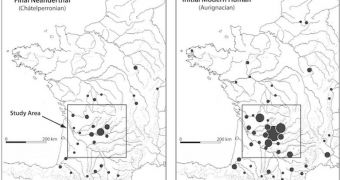For many years, historians and archaeologists have been trying to piece together the history of what happened with the Neanderthals that used to inhabit Europe and Asia some 35,000 to 45,000 years ago. A new study reveals that Homo sapiens replaced this species due to its large numbers.
Neanderthals were the first to leave Africa after hominids evolved. They settled fertile areas in Europe and Asia, and thrived there for thousands of years. Historical records show that the arrival of Homo sapiens in these areas coincided with the disappearance of our competitors.
Studying what really happened is made all the more difficult by the fact that, at the time, there were also other factors that may have contributed to Neanderthals' decline, such as for example massive volcanic eruptions.
These may have changed the climate sufficiently to make the species vulnerable to external influences, such as for example Homo sapiens. However, the new investigation suggests that our ancestors simply overwhelmed the competition through sheer numbers, Wired reports.
Analysis indicates that the ratio may have been as high as 9 to 1 in our ancestor's favor. Under these circumstances, the competition never stood a chance, researchers at the Cambridge University write in the latest issue of the top journal Science.
The research was conducted in the Aquitaine region of southern France, where numerous archaeological sites from more than 35,000 years ago exist. These locations provide experts with study grounds to investigate the settlement of Europe.
When investigating the size of regions that were occupied by the two species, researchers determined that Neanderthal settlements had a surface area of about 200 square meters, whereas Homo sapiens villages could cover up to 600 square meters.
Throughout the Mouterian and Chatelperronian eras, Neanderthals lived and thrived at all locations. As the latter ended and the Aurignacian period began, modern humans began to take hold of the land, occupying their competitors' settlements, and pushing them further back.
Stone tools and animal food remains also testify that our ancestors were a lot more numerous than Neanderthals. In this regard, the amount of data provided by the French research sites was invaluable.
At this time, scientists are not exactly sure what gave our ancestors the competitive age over the other hominids. One possible explanation could be that Homo sapiens had improved food storage.
At the same time, an increased amount of social cohesion and the potential for trade and the exchange of goods may have also contributed to its chances of survival.

 14 DAY TRIAL //
14 DAY TRIAL //